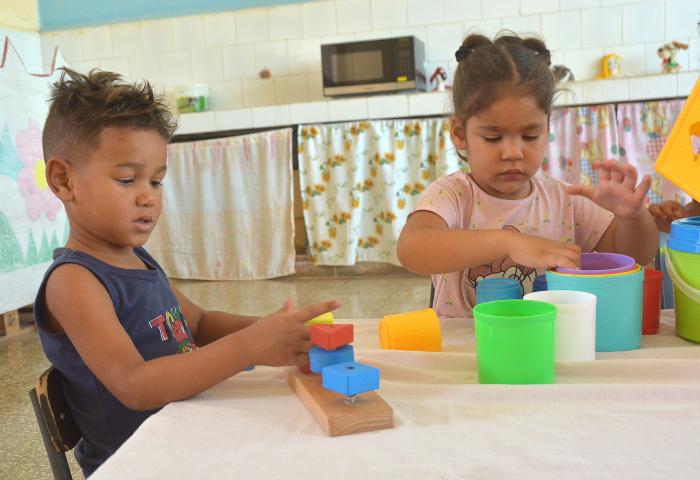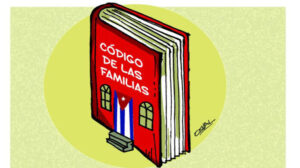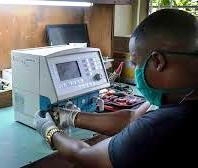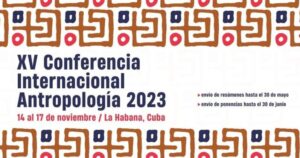Tomorrow, everyone will have a different story to tell: The day, for example, when his parents were called because, naughty as he was, he broke the chair he was sitting on and the teacher explained to him, with candid words and wise patience, why a «polite and good» child should not behave like that.
Or the day when the mother arrived later than usual, and the daughter asked her why she was late: «Mummy, why are you arriving at this hour?»
Or children drawing the path of Gigetto or the oval leap of the frog, some of the first strokes; perhaps, among the most difficult to achieve muscular control of the little ones.
So many stories!
Stories in a context in which opening new children’s circles in Cuba is extremely complex, but another equally beautiful work continues to gain space: the children’s houses.
Arriving at such a place is always a milestone in the life of any child and his or her family. They are calm hearts that leave for their daily chores, while the greatest of treasures is in the care of professionalism and love.
JOY AND COLOUR
At first glance, you wouldn’t imagine that there is so much tenderness, joy, colour and security inside a mass of concrete and concrete. But there is all this and more in the children’s house Luces de mi Patria, located in the council of Patria, where there are four schools and, paradoxically, no children’s circle.
Luces de mi Patria opened its doors under Resolution 58/2021 of the Ministry of Education, which establishes the regulations for the opening and operation of children’s centres in companies, budgeted units, agricultural and non-agricultural cooperatives, joint ventures, political organisations…
This is how the aspirations of many mothers in the community and the surrounding area became a reality, as they saw the realisation of a desire that seemed unattainable years ago. This is how the workers of this exceptional site, a few kilometres away from the city of Morón, Avileña, see it.
The initiative, under the protection of the educational sector in the municipality, which ensures its maintenance and sustainability, responds to the demands of the demographic dynamics to encourage birth rates in the face of limited capacities in children’s circles, and is one of the achievements of the National Programme for the Advancement of Women.
At the same time, it is one of the 44 children’s homes supported by Unicef Cuba, as part of the project Increasing educational coverage for early childhood, through the institutional modality. Strengthening comprehensive education and implementation of parenting programmes with a gender focus in Cuba.
Yeisy Llanes Arcia, a graduate in early childhood with several years of experience in children’s circles, and director of the casita, explains that the first thing that goes through many mothers and fathers’ minds is to think about who will have a harder time, the child or the adult, because adapting to the process is not always easy.
It is the first time the child is separated from home to adapt to an unfamiliar world. «All this presupposes a change in the child’s life, which is why the fostering process becomes for everyone a gentle and caring process.
Visney Gamboa Cobas, a member of a micro-enterprise dedicated to construction, testifies to this. «I have my daughter here. Life is less complicated for me. I work without worrying. When I leave, I know that my daughter is in good hands. My son also went through this little house.
Midely Durán Cid has a similar opinion: «For working mothers, it allows us to continue our work. It is an immense peace of mind to know that you leave your child well cared for, in a place with optimal conditions and hygiene. The children’s house is a jewel, beautiful, and there the children play, develop and learn to interact with other children.
«My son is hyperactive. He needs more activity. That’s why I often take him to the ball field to use up his energy and go to bed early. When he finishes his stay, I am sure he will enter Camilo Cienfuegos primary school better prepared.
Diana Rosa Gómez Pereza, administrator, is in charge of provisioning and ensuring a good, stable and varied diet. «My children eat a main course every day. We receive food from Acopio in the municipality, from the Comercio sector and from the community square. They have a snack and are fed with the right food, with the right percentage of calories for each age group.
Odalys Sánchez Díaz, a methodologist who looks after the five children’s homes in the municipality of Morón, says that all of them have received equipment to guarantee better functioning and learning, as well as educational and teaching materials. As a result, 89 children have benefited from quality early childhood education spaces.
Over the years, these institutions have gained acceptance and recognition, both in the workplaces where they are located and in the communities to which they belong, as well as among the parents who receive this benefit.
The most difficult teaching is in the sixth year of life (five to six years), says Sánchez Díaz, because they teach pre-writing and phonic analysis. All the basics to enter primary school.
Life becomes more complex until they reach preschool. They have to leave the little house recognising the natural numbers up to ten, forming words, among other actions so that in the first grade they don’t have to do any work.
The neighbourhood also considers them to be support centres for children in vulnerable situations who do not go to children’s circles, as in the case of Raus Ani and Rousniel.
For the workers, it is a solution, a safe centre, with educational assistance and at a lower cost than private services (care homes and private childminders).
Another advantage is that mothers, fathers or persons responsible for the children can have access to sources of work and income for their family’s welfare.
For the organisation hosting the children’s home, it means greater efficiency, because the employees feel that their children are close to their workplace. In addition, the children are guaranteed protection, medical care and comprehensive education in accordance with their developmental needs.
Another detail is that punctuality is favoured, both at the entrance and exit of the centre, according to the established schedules, since intermediate transfers are reduced, as the educational institution is located in the same company or in neighbouring areas.
The United Nations Children’s Fund (Unicef), an organisation that works in the most difficult places in the world, has put its hands in the project of the children’s houses in Cuba. On the Big Island it also accompanies the implementation of the community social programme «Educate your child», and is committed to continue strengthening early childhood education.
FACES AND ATTITUDES
You go inside and you see as many faces as attitudes. Leider, the shy boy who started crying when he saw the camera; Yánder, who wants to go fishing; Isaías and Flabia, who want to see the photos taken by Aparicio; Raus Ani and Rousniel, the jimaguas who feign uneasiness; the other pair of jimaguas from the Casita: Diego and Tiago, who hug each other out of love; Loiner, who lowers his head at strangers; Carla, who is hyperactive and shares toys with her little companions, although she wanted to take away Yabdiel’s….
They are all wonderful, exceptional. They are children, and although they don’t understand much about the daily hustle and bustle, you can tell that they are happy here.




